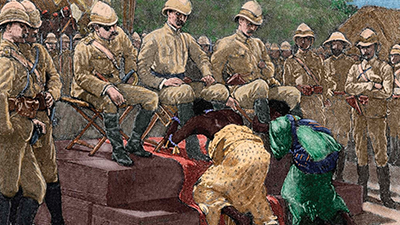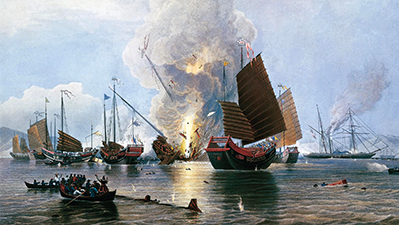Industrial Imperialism
Driving Question: How did the rise of industry contribute to the rise of empires?
Imperialism wasn’t new, but this was a different kind of imperialism. Industrialization gave empires new strategies, weapons, and tools of communication and transportation. As a result, industrial empires rapidly expanded their territory in this period.
Learning Objectives:
- Evaluate the tools used by imperial powers to expand their empires.
- Build image-analysis skills to examine differing perspectives on imperialism during the nineteenth century.
- Use the historical thinking practice of claim testing to identify, assess, and use authority and evidence when evaluating and making claims.
Vocab Terms:
- administrator
- bureaucracy
- colonialism
- imperialism
- profit
- racism
- segregation
Opener: Industrial Imperialism
To teach this lesson step, refer to page 2 of the Lesson 6.2 Teaching Guide.
Our Openers and Closers Guide will provide more information about these short, but important, activities at the beginning and end of each lesson.
Start connecting industrial advances to imperialism by looking at how new technologies and economic systems gave empires more reach, control, and ambition.
The New Imperialism
To teach this lesson step, refer to page 3 of the Lesson 6.2 Teaching Guide.
Check out this discussion on modifying the three-step reading tool for your students.
These materials introduce the “new” imperialism of the nineteenth century. You’ll examine how industrial power changed imperial strategies, and how people critiqued and resisted imperial rule.
-
Guiding Questions
-
Before you read
Preview the questions below, and then skim the article. Be sure to look at the section headings and any images.
While you read
Look for answers to these questions:
- In what ways were late nineteenth-century empires similar to earlier ones?
- What made these newer empires different from earlier ones?
- How did technology support the spread of imperialism?
- How did capitalism, industrialization, and racism create motives for empire?
- What role did nationalism and “men-on-the-spot” play in expanding empire?
After you read
Respond to these questions: Which reasons for the rise of new imperialism do you find most convincing? Which seem less important, and why?
Ideology, Industry, and Guns
To teach this lesson step, refer to page 7 of the Lesson 6.2 Teaching Guide.
Teachers share their experiences with using the Imperialism Cartoons activity in this thread on the OER Project Community forum.
Check out this video to explore how claim testing is really making and testing claims.
Examine the tools of empire and explore different perspectives on imperialism and its impact through powerful political cartoons.
-
Guiding Questions
-
Before you read
Preview the questions below, and then skim the article. Be sure to look at the section headings and any images.
While you read
Look for answers to these questions:
- What’s the difference between colonialism and imperialism?
- What ideas or beliefs helped support imperialism?
- What technologies helped imperial powers expand?
- What is gunboat diplomacy?
- How did science and indirect rule help support empire?
After you read
Respond to this question: How were the tools of imperialism connected to other changes in this period, such as industrialization, capitalism, and political revolutions?
Closer: Industrial Imperialism
To teach this lesson step, refer to page 13 of the Lesson 6.2 Teaching Guide.
Wrap up the lesson by thinking critically about industrial imperialism and how it relates to other global changes you’ve explored.
Reviewing for Analysis and Evidence
To teach this lesson step, refer to page 14 of the Lesson 6.2 Teaching Guide.
How do students know what to write? Check out this blog post about writing historical essays.
By suggesting revisions to someone else’s writing, you’ll get much better at identifying what makes strong writing. Make suggestions for improving analysis and evidence—and then keep those suggestions in mind the next time you write.






